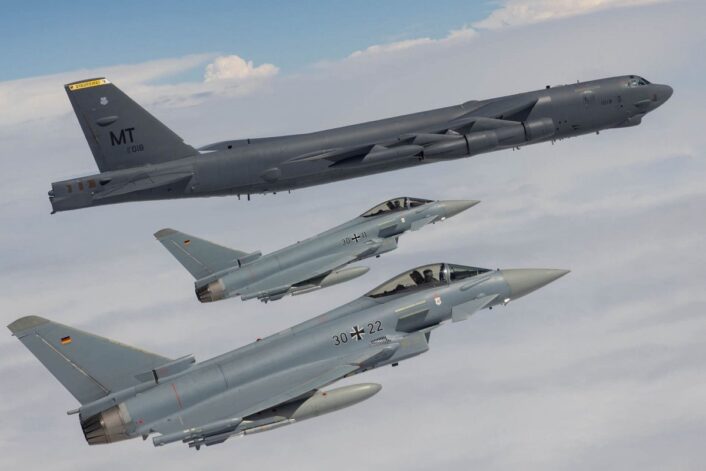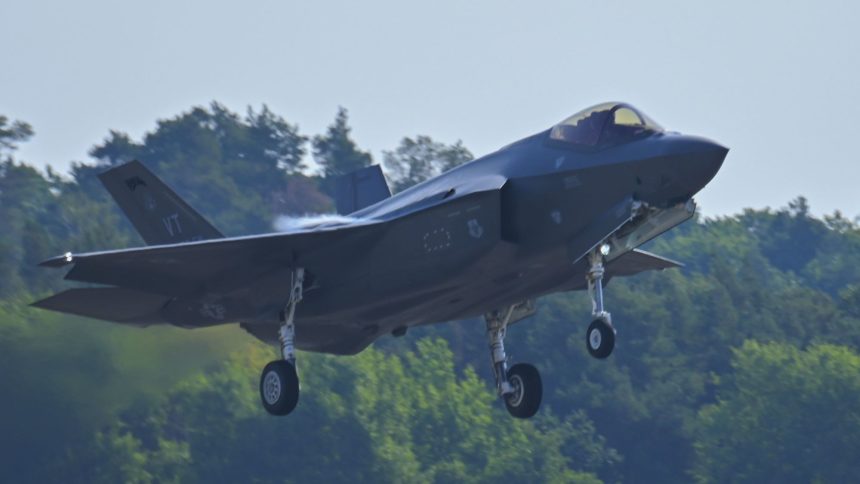Germany has already contracted 35 F-35As, and the additional aircraft would take its planned fleet to 50 airframes.
Nearly seven months after German media reported the country’s Minister of Defense Boris Pistorious backing his country’s choice to acquire 35 F-35 Lightning IIs, and vehemently denying speculations about a rethink, Der Spiegel has now reported budgetary requests for an additional 15 airframes.
The publication reported that the information is among the military projects mentioned in “confidential documents” submitted to the Bundestag’s Budget Committee. Should the new acquisition be approved, the Luftwaffe’s planned fleet would reach 50 aircraft.
Quoting the classified documents, Spiegel said: “Pistorius’ planners estimate a budget of €2.5 billion for the 15 additional high-tech fighter jets from US manufacturer Lockheed Martin.”
The first of the Luftwaffe’s 35 F-35As are scheduled to be delivered by 2026-2027, as per the Dec. 15, 2023, $8.4 billion deal, and would be based at Büchel Air Base. That base is home to the 31st Fighter-Bomber Squadron, and also stores American B61 nuclear bombs, to be used by the Tornado aircraft based there as part of NATO’s Nuclear Sharing Agreement.
🇩🇪 Spiegel reports that Germany is looking at procuring an additional 15 F-35A multi-role fighter jets to replace the ageing Tornado.
Such a purchase would bring the total German F-35A fleet to 50 aircraft, which, in combination with the 20 Eurofighter Tranche 5 and 15… pic.twitter.com/EeebaNdzR1
— Jeff2146🇧🇪 (@Jeff21461) October 20, 2025
Luftwaffe’s and Deutsche Marine’s current fleet and future plans
The F-35A is meant to replace the Tornado IDS (Interdictor/Strike) variant and take over NATO’s nuclear role, which the variable sweep aircraft has been assigned for years. Eurofighter Typhoons, also operated by Germany, are not certified to carry that atomic weapon.
As per Flight Global’s World Air Forces 2025 report, the Luftwaffe operates 64 Tornado IDS jets – that have been cleared to operate the B61, and 21 Tornado ECR (Electronic Combat/Reconnaissance) jets. Its number of Typhoons currently stands at 129 aircraft and, on Oct. 15, 2025, Germany ordered 20 new Tranche 5 jets, a week after the Bundestag approved the purchase on Oct. 8.
Germany also wants four more P-8A Poseidon Maritime Patrol Aircraft, according to budget and naval plans, taking its total future fleet to 12 aircraft, from the eight it had initially contracted. Germany received the first of its P-8As on Oct. 2.
NEW: Germany plans to buy 15 more F-35 fighter jets from Lockheed Martin for about €2.5 billion, on top of the 35 already ordered.
Source: Reuters pic.twitter.com/0s95dOZlvs
— Clash Report (@clashreport) October 20, 2025
‘More F-35As are crucial’
The reports about Germany reconsidering its participation in the F-35 program came amid rumors about the U.S. wielding a special “kill switch” to remotely deactivate all global F-35 fleets in retaliation for diplomatic dissent. However, as we explained here at The Aviationist, the control over F-35s has more to do with restricting the supply of parts, components or critical software upgrades that can hamper the stealth jet’s operational capability, or even flyability.
Der Spiegel quoted unnamed officials from “security circles,” who said that the “renewal of the Air Force fleet is strategically important [and] essential” for both the “nuclear sharing” role and for the Bundeswehr to “meet the new NATO requirements” in the future. “The alliance has significantly strengthened its defense and deterrence plans due to the Russian threat, and air superiority is considered a central element of the new concept,” added the report.
Early in September, drones from Russia violated Polish airspace, spurring NATO to launch Operation Eastern Sentry in Poland, with the RAF’s Typhoons from RAF Coningsby also deploying in the effort to bolster the alliance’s eastern flank. On Oct. 15, Pistorious announced German contributions to NATO’s Enhanced Vigilance Activity Eastern Sentry, listing Luftwaffe’s deployment to Poland’s Malbork, besides its jets already deployed to Constanta in Romania.

“To secure our capabilities over the coming years, Germany will invest €10 billion in drones of all types and all altitudes – both attack and defence drones – in line with its budget planning,” further said the report. On the naval front, DW mentioned in a May 16, 2025, report German and British efforts to develop a long-range missile, and future joint ASW and maritime patrol operations in the North Sea and North Atlantic.
Luftwaffe Typhoons, along with jets from Finland, Poland, and the U.S. as “contributor” nations, are currently participating in NATO’s annual Steadfast Noon nuclear deterrence exercise. Exercise operations are centered at Volkel Air Base (Netherlands), Royal Air Force Lakenheath (United Kingdom), Kleine-Brogel Air Base (Belgium), and Skrydstrup Air Base (Denmark).
The F-35 and the Tornado are NATO’s “dual capable” aircraft which, as mentioned earlier, are cleared to operate the B61-12 nuclear bomb. The arrival of F-35As with the service will naturally expand NATO’s nuclear delivery arsenal in Europe.
Steadfast Noon is scheduled to run until October 24, involving 70 aircraft from 14 Allied countries and takes place across four host nations, as well as the airspace over the North Sea region.
📸@SHAPE_NATO
Learn More: https://t.co/cr6Hrkkq7n pic.twitter.com/iKNck2h8pf
— NATO Air Command (@NATO_AIRCOM) October 20, 2025
Cost implications and FCAS
The Der Spiegel report however cited cost implications of the current infrastructure work at Büchel Air Base to support the F-35As, which have risen from the original €700 million to €2 billion. In a previous report, Der Spiegel noted the need to hire more personnel to speed up the work, the technical complexity of construction at high altitudes and rising building material prices contributing to the spike in costs.
❗️🇩🇪Germany plans to purchase an additional 15 🇺🇸American F-35A fighters to the 35 already ordered pic.twitter.com/nofrAXVtd5
— 🪖MilitaryNewsUA🇺🇦 (@front_ukrainian) October 20, 2025
Germany would likely also need additional fifth generation fighters following its divergence with France over the sixth-generation FCAS (Future Combat Air System). This divergence emerged as Dassault is demanding 80% of the workshare, instead of the 50% to split the work equally with partners Airbus and Indram, in order to get the delayed program moving.









